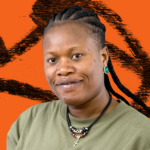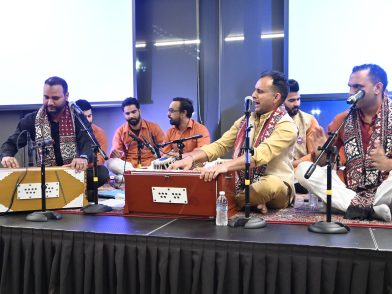My cousin, Fatema, knew she would get cut because many of our friends had it done—standard for girls in Sierra Leone. Our friends had told us that cutting was painful, so we were terrified. The cut happened when Fatema’s mother, my aunty, was away.
Distant relatives we couldn’t recognise told Fatema it was “your time”. The woman who cut Fatema was my aunt’s friend. The cutting took place in the middle of a noisy bush with the sounds of birds at night. Aunt Friend used ropes to tie Fatema’s legs apart. I could hear screams like birds at night. There was so much blood in the morning.
I didn’t see my cousin for many nights until she came out from the bush on a sunny Saturday afternoon with the sounds of musical beaten drums: the dress code was all pink. We gathered at the town hall for a celebration with cassava leaves, jollof rice, palm wine and soft drinks.
News of the just-cut girls was the talk of the town. The whole story changed when I saw my cousin struggling to urinate.
At thirteen, I came home from school on a Monday. My aunty said to me “your time” was that Friday. I stayed up all nights fearing being grabbed, tied up and taken to the Bondo bush. I went to school on Thursday and never returned. I ran far away. I found sanctuary in a church at Targrin village in Lungi. I stayed for two weeks. My family said they searched for me, they informed the police, and my name was announced on the radio as a missing child.
My family thought I was kidnapped. But I was in safe hands, preparing to face my future as an advocate against female genital mutilation (FGM). When I finally returned home, I told my mother and aunties that I would never allow them to cut me. Every school holiday, I would find ways to go and stay with the family that rescued me at the church so I could be safe from cutting.
My mother, who is in support of FGM as she was cut in her childhood, gave up on me when I enrolled in university. Mother said to me: “I will not force you to be cut. It’s up to you to decide to favour your womanhood.”
The practice of FGM has deep roots in Sierra Leone’s culture and politics, giving rise to crucial hindrances to criticism of the tradition. Girls below the age of eighteen are not safe in their houses, schools, and communities. The Soweis could cut their genitals at any time with or without the permission of their family members. Those above eighteen are equally afraid because their status as adults doesn’t matter.
Female Genital Mutilation is practised nationwide by groups of women led by the Soweis who have pledged allegiance to the Bondo Society in every village and town across Sierra Leone. FGM is a significant tool in the political system in which girls could be traded for votes. This enhanced Bondo Society’s power to convince and instruct women on how to vote and who they should cast their votes for. Thus, eradicating the FGM practice in Sierra Leone is a taboo for politicians. A popular Sowei, Ya Alimamy Kamara, once said: “It’s not just about culture; it’s our way of life and its power. Traditionally, politicians talk through us if they want to engage the communities. We are like a link between them and the women.”
This is why any attempt by opposers to force the Soweis to stop FGM is seen as an attack on a type of African rooted in prehistoric rituals. Rituals that, according to Soweis, were created to fortify young girls against evil spirits and prepare them for puberty and womanhood.
Female Genital Mutilation is excruciating. The tools uncertified Sowei use are unsterilised—blades, knives and scissors are used to cut the girls. After the initiation, newly cut girls are kept in the enclosed Bondo Bush for a couple of days, weeks or sometimes even months to heal while learning lessons about adulthood.
Female Genital Mutilation is excruciating. The tools uncertified Sowei use are unsterilised—blades, knives and scissors are used to cut the girls. After the initiation, newly cut girls are kept in the enclosed Bondo Bush for a couple of days, weeks or sometimes even months to heal while learning lessons about adulthood.
In Sierra Leone, according to the 2019 Demographic Health Survey, 83 per cent of women aged 15-49 have undergone FGM, a decrease from 90 per cent in 2013. Among women who have heard of FGM, 48 per cent believe that it is not a requirement of their religion (Islam and Christianity), and 34 per cent believe that FGM should not be continued.
The prevalence of FGM in Sierra Leone increases with age. 61 per cent of women aged 15-19 have undergone FGM as compared with 95 per cent of women aged 45-49. 87 per cent of Muslim women are more likely to have had FGM compared to 69 per cent of Christian women. The percentage of women who have had FGM is higher in rural areas than in urban areas (89 per cent and 76 per cent, respectively). The prevalence of FGM is highest in the Northwest province (93 per cent) and lowest in the Southern province (74 per cent). By district, the prevalence of FGM is highest in Karene (98 per cent) and lowest in Bo (65 per cent).
My mother, who is in support of FGM as she was cut in her childhood, gave up on me when I enrolled in university. Mother said to me: “I will not force you to be cut. It’s up to you to decide to favour your womanhood.”
I struggled to challenge the practice of FGM in Sierra Leone. I voiced my opinion on live radio shows and assembled young girls at school and communities to talk to them about the negative impact of FGM.
I faced backlash from members of the Bondo society, traditionalists, family and political figures. I was even targeted by some members of the Bondo society, who threatened to perform FGM on me if I continued with my activism.
My advocacy led me to become a journalist. Initially, I arrived in Australia in 2018 to cover the Commonwealth Games hosted in the Gold Coast. Before my arrival, and during my time covering the Games, I faced death threats for standing up against FGM in Sierra Leone.
Due to the persistent threat I feared returning to Sierra Leone so I sought asylum in Australia. The process of gaining protection here is very long. I got denied after my first hearing and appealed the decision. My case was at the Administrative Tribunal for over five years. During the long wait, I hoped my case would be heard and they would grant me residency.
Since obtaining asylum, I have engaged in advocacy through the Jesuit Refugee Service Leadership program. I have advocated for the rights of asylum seekers in many schools, churches, and community organisations across NSW. Also, I have constantly engaged the media in Sierra Leone through radio interviews, newspaper publications, and social media campaigns against the practice of Female Genital Mutilation.
Globally, it is estimated that some 200 million girls and women alive today have undergone some form of FGM. Although FGM is declining in most countries where it is prevalent, most of these are also experiencing a high rate of population growth. An estimated 68 million girls are at risk of being mutilated by 2030.
This story was supported by Diversity Arts Australia’s StoryCasters program in partnership with The New Point Magazine. The views expressed within this story do not necessarily reflect the views of Multicultural NSW.
Explore other topics —



